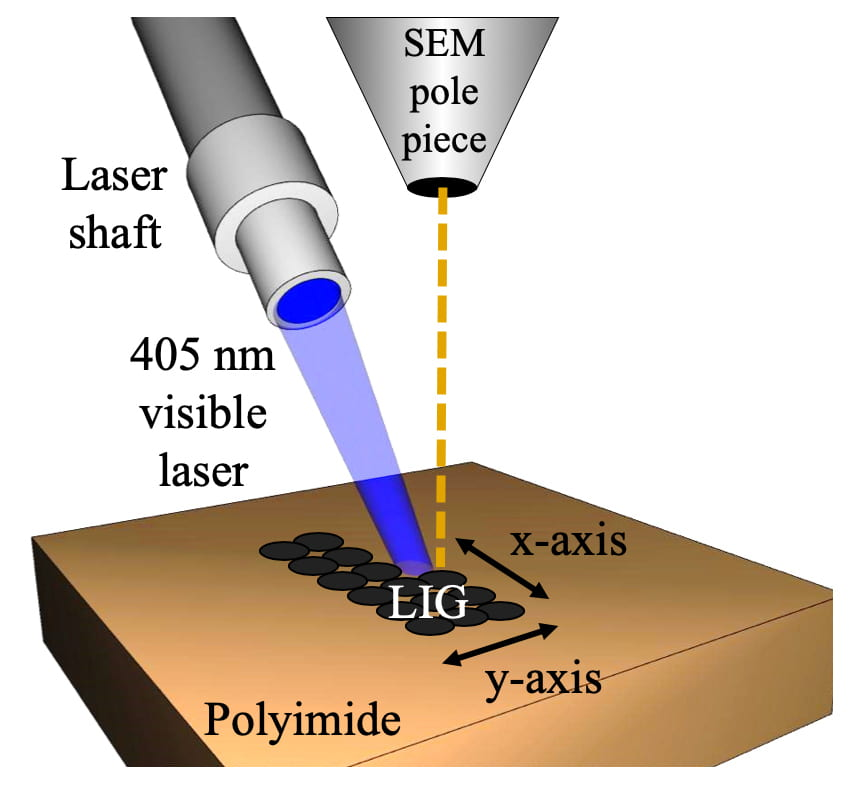Feb 13 2020
A large laser is not required to make laser-induced graphene (LIG). A research team at the University of Tennessee, Knoxville (UT Knoxville), Rice University, and Oak Ridge National Laboratory (ORNL) are utilizing an extremely tiny visible beam to burn the foamy version of carbon into minute patterns.
 Scientists recorded the formation of laser-induced graphene made with a small laser mounted to a scanning electron microscope. Image Credit: The Tour Group.
Scientists recorded the formation of laser-induced graphene made with a small laser mounted to a scanning electron microscope. Image Credit: The Tour Group.
The laboratories of Rice chemist James, which in 2014 had identified the original technique to change a standard polymer into graphene, and Philip Rack a Tennessee/ORNL materials scientist—demonstrated that the formation of conductive material can now be observed as it makes tiny LIG traces in a scanning electron microscope (SEM).
The modified process has been described in the American Chemical Society’s ACS Applied Materials & Interfaces journal. It produces LIG with features that are over 60% smaller compared to the macro version and nearly 10 times smaller than normally obtained with the previous infrared laser.
According to Tour, the process is also made less expensive by lower-powered lasers. This may result in a wider production of flexible sensors and electronics at the commercial level.
A key for electronics applications is to make smaller structures so that one could have a higher density, or more devices per unit area. This method allows us to make structures that are 10 times denser than we formerly made.
James Tour, Chemist, Rice University
To demonstrate this concept, the laboratory created flexible humidity sensors that cannot be seen by the naked eye and are directly produced on a commercially available polymer—polyimide. These sensors were able to perceive the breath of humans with a response time of just 250 milliseconds.
This is much faster than the sampling rate for most commercial humidity sensors and enables the monitoring of rapid local humidity changes that can be caused by breathing.
Michael Stanford, Study Lead Author and Postdoctoral Researcher, Rice University
Within the blue-violet portion of the spectrum, the tinier lasers pump light at a wavelength of 405 nm. These lasers are less robust than the industrial lasers that are being used by the Tour Group and others across the world to burn graphene into wood, paper, plastic, and even food.
The laser mounted by the SEM burns just the top 5 μm of the polymer, writing graphene features down to 12 μm. (By comparison, a human hair has a width of 30 to 100 μm)
Working directly with ORNL allowed Stanford to leverage the sophisticated equipment of the national laboratory. “That’s what made this joint effort possible,” added Tour.
“I did a lot of my Ph.D. research at ORNL, so I was aware of the excellent facilities and scientists and how they could help us with our project,” added Stanford. “The LIG features we were creating were so small that they would have been next to impossible to find if we were to lase the patterns and then search for them in the microscope later.”
According to Tour, whose team had recently launched flash graphene to immediately convert food waste and trash into useful material, the novel LIG process provides a whole new opportunity for writing electronic circuits into flexible substrates, for example, clothing.
While the flash process will produce tons of graphene, the LIG process will allow graphene to be directly synthesized for precise electronics applications on surfaces.
James Tour, Chemist, Rice University
The study’s co-authors are postdoctoral researcher Cheng Zhang and graduate student Anna Hoffman from UT Knoxville, research and development scientist Ilia Ivanov from ORNL, and staff scientist Jason Davidson Fowlkes from UT Knoxville and ORNL.
Tour is the T.T. and W.F. Chao Chair in Chemistry and also a professor of computer science and of materials science and nanoengineering at Rice University.
Rack is a professor and the Leonard G. Penland Chair and associate department head of materials science and engineering at UT Knoxville. He is also a joint staff at the Center for Nanophase Materials Sciences at Oak Ridge.
The study was supported by the U.S. Department of Energy and the Air Force Office of Scientific Research.
Graphene forms under microscope’s eye
Video produced by the Tour Group at Rice University and Oak Ridge National Laboratory. Video Credit: Rice University.